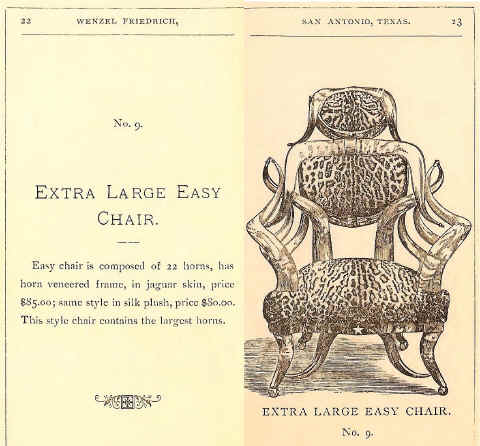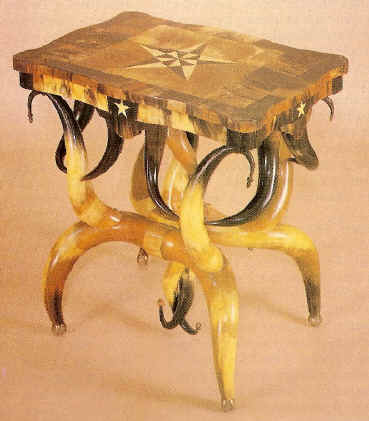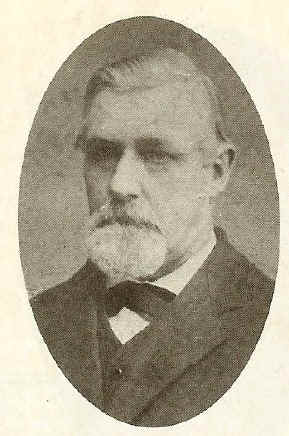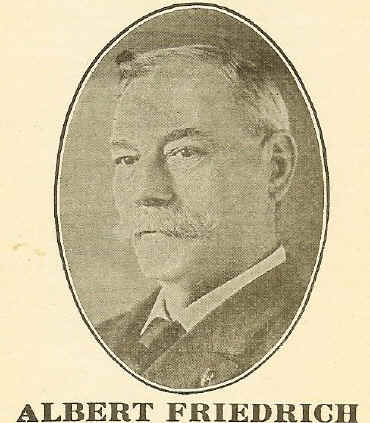-
Wenzel Friedrich (1827–1902)
-
Antiques
-
- Wenzel Friedrich
- (1827–1902)
- 1883 Horn chair Buckhorn Saloon
- Pictured in his 1883 Catalog
- View Details
- Contact for Price & Info
-
- Wenzel Friedrich
- (1827–1902)
- Horn Chair Circa 1885
- Same Chair is pictured on the cover of the Wenzel Friedrich 1890 Catalog. It is either a # 6 1/2 , #7 or #8 Horn chair. They are all similar. Good original unrestored condition.<br><br><br><br>Horn Furniture
- View Details
- Contact for Price & Info
-
- Wenzel Friedrich
- (1827–1902)
- Horn "Fancy Arm Chair" No. 7 or No. 8 in his 1890 catalog
- New Axis hide upholstory Circa 1880s
- H-41" x W-35" x D-29"
- <br>Horn Furniture
- View Details
- Contact for Price & Info
-
- Wenzel Friedrich
- (1827–1902)
- Horn Chair
- All original upholstery. Very rare to find one that has never been recovered.<br><br><br>Horn Furniture<br>
- View Details
- Contact for Price & Info
-
- Wenzel Friedrich
- (1827–1902)
- Horn "Lady's or Parlor Chair" No. 4 in his 1890 Catalog
- Circa 1880s
- H- 38" x W-26" x D 27"
- Only one of two known.<br><br><br>Horn Furniture<br>
- View Details
- Contact for Price & Info
-
- Wenzel Friedrich
- (1827–1902)
- Horn Chair
- Circa 1880s - New Axis Hide Upholstery
- H-37" W-31" L-24"
- # 2 Horn Chair in his Catalog.<br><br><br>Horn Furniture
- View Details
- Contact for Price & Info
-
- Wenzel Friedrich
- (1827–1902)
- 1880s Horn Chair
- H: 38 3/4 W: 30 5/8 D: 23 1/2
- Texas cowboy western saloon
- View Details
- Contact for Price & Info
-
- Wenzel Friedrich
- (1827–1902)
- Horn "Arm Chair" No. 2 in his 1890 Catalog
- Circa 1880s
- H- 40" x W- 32" x D- 27"
- horn furniture<br>
- View Details
- Contact for Price & Info
-
-
Biography
Wenzel Friedrich (1827–1902)
FRIEDRICH, WENZEL (1827–1902). Wenzel Friedrich, horn furniture maker, was born in Grünthal, Bohemia, on July 2, 1827. In 1853 he emigrated, landed at Indianola, Texas, and settled in San Antonio. He soon established himself in cabinetmaking, a trade he had learned in Bohemia. He became a founding member of San Antonio's first volunteer fire department and later was a charter member of the Number Two Fire Company. On December 8, 1854, he married Agnes Urbaneck. The couple had seven children; their youngest son, Albert Friedrich, was founder of the Buckhorn Saloon. In 1880 Friedrich expanded his cabinetmaking business to include the manufacture of horn furniture. It has not been established whether he originated horn furniture, but over the next ten years he crafted some of the most innovative. His works received awards of merit at the Cincinnati Industrial Exposition of 1883, the New Orleans Industrial and Cotton Centennial Exposition of 1884–85, and the Southern Exposition at Louisville, Kentucky, in 1886. Between 1880 and 1890 his furniture, noted for its quality, was sold throughout the United States and Europe. His patrons included Queen Victoria, Otto von Bismarck, and Kaiser Wilhelm I. Friedrich died in San Antonio on November 7, 1902. Today his furniture is displayed in museums throughout the United States.
The Buckhorn, Wenzel
Friedrich
&
Billie Keilman's Horn Palace
The Buckhorn Saloon was founded in 1881
by Albert Friedrich, son of cabinet maker and famed horn furniture maker, Wenzel
Friedrich, who, beginning in 1880 made among the most beautiful horn furniture. The
Buckhorn was located on Dolorosa Street in San Antonio. Albert was very fond of deer
antlers and cattle horns, which he used to decorate his saloon. As word of this got
around, he began offering to trade a drink for horn or antler specimens. The collection
grew, and over the years it became larger and larger -- and so did the Buckhorn's
reputation. It became a San Antonio landmark and was known around the world. In its
heyday, it was the largest horn collection in America.During the same time,
another massive collection of horns and mounted specimens was being gathered by
saloon-keeper Billie Keilman who displayed them in his Horn Palace in San Antonio,
beginning in 1912, an establishment well-known for its chicken dinners, music and
nightlife. Billie claimed to have the largest horn collection in the world with over 5000
specimens from many countries. The Horn Palace was sold to the Buckhorn in 1921, which
then made it the undisputed horn king of San Antonio. What remains of the Buckhorn's
collection may be seen today in San Antonio.
Mounted horns were sold from the
Buckhorn Curio Shop in San Antonio.
These steer horns, once in the Buckhorn collection, are a better grade example of twist
and curl, common to early Texas cattle.
Wenzel Friedrich, maker.
San Antonio, Texas.
Two chairs of the 1880's.
Acorn finials of horn.
Tiffany glass ball casters.
Materials offered on Friedrich chairs include:
* a silk plush (velvet)
* hides from cattle, angora goat, jaguar, catamount and fox,
* and a cane and walnut seat on his office chair model.
The Tiffany glass ball casters
were also used by Charles Puppe and William Mittmann, horn furniture makers of the 1880's
in San Antonio. Mittmann also fitted the tips of his horns with acorn finials.
By 1884, Friedrich was having
trouble finding in his own area the size and shape of horns he wanted for his furniture
and began seeking a supply from Old Mexico.
A classic Wenzel Friedrich horn chair.
Among the most beautiful of all horn chairs ever
made. Friedrich offered this platform rocker, with horn-veneered seat frame, inlaid ivory
star, and two cushions in cat hide. Sold new in 1889 for $80.
Among the rarest of all
Friedrich chairs. Having the glass ball casters, veneered seat frame, two back cushions,
and acorn finials.

As of May 2015, this is the only known example of this style of Friedrich chair. Seen here
on display at the Boot Hill Museum in Dodge City, Kansas.
The beautiful horn--veneered table
by Wenzel Friedrich,
San Antonio, Texas.
Made in the 1880's.
The top is 19x27 inches.
Has his trademark inlaid ivory star on four sides.
When new, this table was priced at $225.
A San Antonio landmark from 1912-1921, having over 5000
mounted specimens.
Billie Keilman
Saloon Keeper
Born 1875
Died 1925
The Horn Palace and the
Buckhorn
Billie Keilman (The Horn
Palace)
Wenzel Friedrich & Albert Friedrich (The Buckhorn)by Alan W. Rogers
According to recent
statistics, there are approximately 16,000 museums in America, which are visited yearly by
more than 850 million people. The subject matter of these varies greatly and many seem to
be of a general nature, having displays relating to all aspects of life. Over the years,
San Antonio has been privileged to have two museums devoted to horns -- the Horn Palace
(founded by Billie Keilman) and the Buckhorn (founded by Albert Friedrich).The Horn Palace
and the Buckhorn
Saloonkeeper Billie Keilman had a strong interest in horns and antlers, and he amassed
what would be come a magnificent collection of such items. Originally called the Horn
Palace Bar and Cafe, it opened in 1912 and, a few years later, was commonly referred to as
The Horn Palace. Toward the end, it was located at 312 East Houston in San Antonio. Housed
in a rather large building, Billie's collection of steer horns, deer antlers and mounted
specimens from the world over was gigantic and became widely known. Painted in a large
letters across the front of the building, the Horn Palace declared to have the largest
collection of horns in the world. Often referred to as a roadhouse, Billie's establishment
featured live bands and dancing, and it became a point of attraction for up-and-coming
musicians. Chicken dinners were a specialty and customers could dine while sitting in horn
chairs made from Texas cattle and, if they chose, could buy a horn chair or horn rocker
and take it home. Large numbers of tourists and patrons came in early-day open-sided buses
to have a part in the excitement.Elsewhere at this time
in San Antonio, another horn collector, Albert Friedrich (son of famed horn furniture
maker Wenzel Friedrich), was busy gathering his own collection of horns and antlers. He,
too, was a saloon keeper, having begun in 1881 when he opened the Buckhorn Saloon on
Dolorosa Street. The Buckhorn would continue as a saloon until the Prohibition era, at
which time it became a curio store, selling steer horns, chair and clocks made of horns,
mounted armadillos, pottery and a dozen other varieties of items relating to the
Southwest.It seems reasonable to
assume Billie and Albert would have a competition of sorts for the steer horns and antlers
available in south Texas, as it was widely known that both were collectors and buyers.
But, in the end, tragedy would favor the Buckhorn.One night in 1921, a
gangland-style shooting occurred at the Horn Palace. Band members were rolling under the
piano and diving out windows for cover.Billie Keilman was shot and nearly killed. The
event was later brought up for trial. But another twist was yet to come. Just before the
trial, the Great Flood of 1921 left 15 feet of water in downtown San Antonio. For reasons
not fully understood but related to the flood, the shooting case was dismissed. This would
mark the end of the Billie Keilman collection. He decided to sell the Horn Palace to the
Buckhorn and, by 1922, the Buckhorn became the undisputed Horn King of San Antonio.The Buckhorn has
undergone several changes over the years, and it may be still seen today. The collection
is smaller now than in the past, as much of it has been sold off. Other displays of old
cattle horns are scattered around the country, some of which have a number of African
imports displayed, although they are advertised as Texas Longhorns. Some museum curators
don't know the difference.With the current
widespread hunting pressures and restrictions on wildlife that may be taken, along with
the cost of taxidermy and labor, we may never again see another horn collection the size
and variety of the Horn Palace. Neither Billie Keilman nor his Horn Palace had a very long
life. He died in November 1925 at age 50. He lived to see his collection combined with the
Buckhorn to form a Texas landmark that, in its heyday, had no equal. Fortunately for those
of us who enjoy horns and history, many photos of the Horn Palace were taken and sold as
postcards and, because of these, we are able to look back in time and revisit this once
grand old horn collection.Billie Keilman
Billie Keilman was born in Bexar County, Texas about 1875, and what he and his family did
in his early years isn't known to me. In the Texas Census of 1910, he is listed as a
saloon keeper. In addition to his obvious business ventures, it appears Billie had another
strong interest -- horns and antlers -- and he amassed what would be come a magnificent
collection of such items, housed in his Texas roadhouse -- the Horn Palace. Billie died
November 1925 at age 50. (Click on link at end of page for photo of Horn Palace chair and
photos of the Horn Palace.)Wenzel
Friedrich
Wenzel Friedrich was born in Gruenthal, Bohemia July 2, 1827 and came to America at age
26. He arrived at Indianola, TX in 1853 and from there made his journey to San Antonio,
which at the time was just a small village and a trading post. After being employed for a
short time in the grocery business, he became a skilled cabinet maker. A trade he was
familiar with in his homeland. He married his childhood sweetheart, Agnes Urbaneck, from
his native country December 8, 1854 and had seven children. In 1880, Wenzel began making
horn furniture at 12 Crockett Street and is listed in city directories as a manufacturer
of horn furniture as late as 1897. He made some of the most beautiful chairs, tables and
hatracks in the United States and is one of only six known makers of horn veneered
furniture. He received gold medals as awards in competition at the New Orleans Industrial
and Cotton Centennial Exposition of 1884-85, the Cincinnati Industrial Exposition of 1883,
and the Southern Exposition of Louisville, KY in 1886. His furniture was sold as far way
as Siberia, to Kaiser Wilhelm I of Bismarck, Queen Victoria of England and the President
of France. Wenzel Friedrich died November 7, 1902 in San Antonio. (Click on link below for
photos of Friedrich furniture.)

WENZEL FRIEDRICH
1827-1902

1864-1928
Albert
Friedrich
In 1881, 26 year old Albert was working behind the bar at the Southern Hotel in SA, a
headquarters for cattlemen of the day. Soon he opened his own small saloon across the
street from the hotel where he had been working, and it is here that his collection began.
Albert was fond of deer antlers and cattle horns and began to decorate his saloon with
such items. Cowboys, trappers and traders and the public in general became aware of
this. Soon Albert offered to trade a drink of whiskey or beer for horn specimens. The
collection began to grow. As his dad Wenzel was a maker of horn furniture, horn chairs
were made for, and added to, the Buckhorn. Over the years, the collection grew and grew.
and expanded beyond deer and cattle and added to the collection were specimens of horns
and mounted heads from American big game animals as well as those from foreign countries.
In 1921 with the closing of Billie Keilman's Horn Palace, San Antonio's other massive horn
collection, and its purchase by Albert Friedrich, the Buckhorn became the undisputed Horn
King of San Antonio. Albert died in 1928. (Click on link below for photos of Buckhorn
furniture.)Copyright Alan Rogers
1991


























